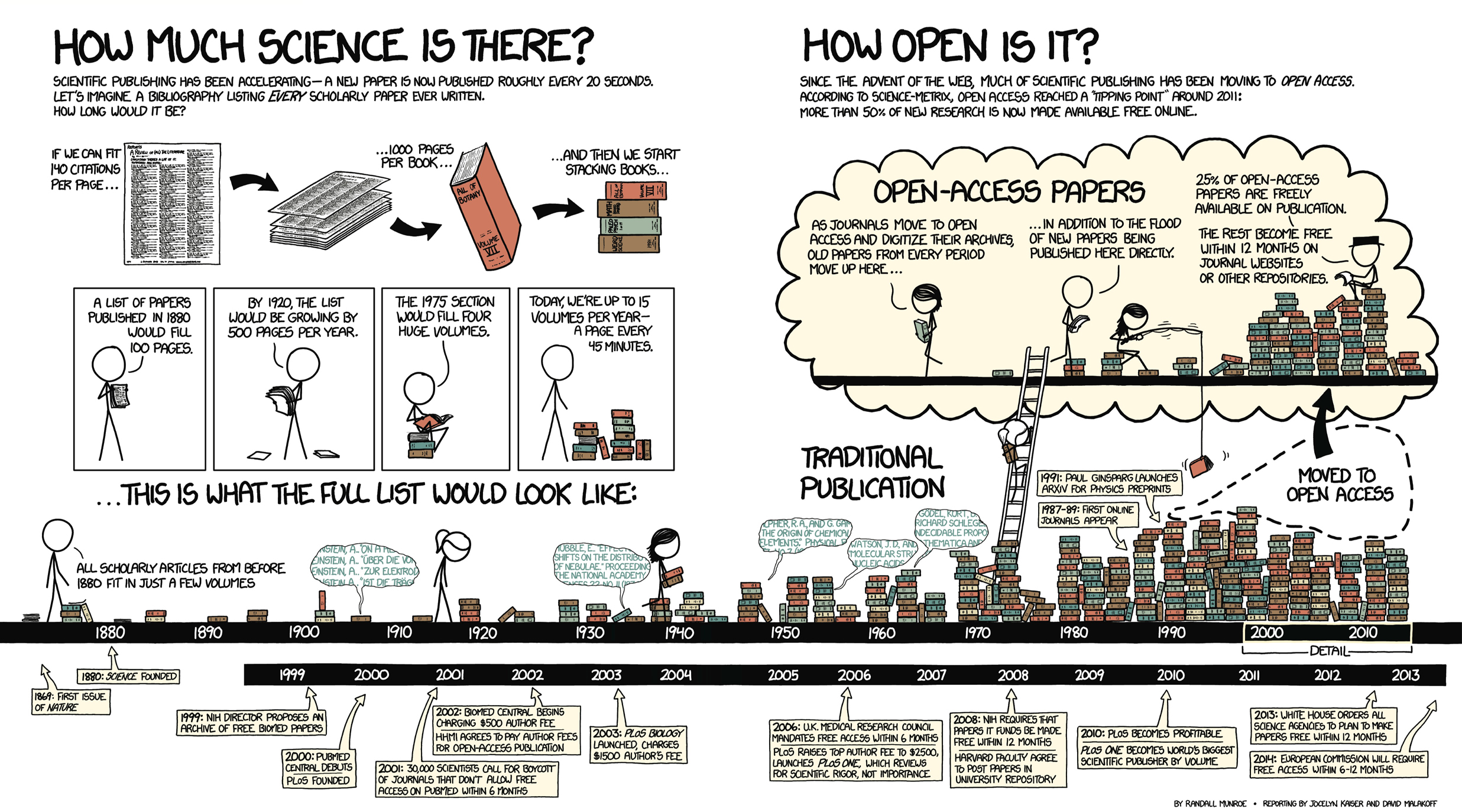The Rise of Open Access
| The Rise of Open Access |
| The accelerating pace of scientific publishing and the rise of open access, as depicted by xkcd.com cartoonist Randall Munroe. |
 |
- The full-size version of this chart can be found here: http://www.sciencemag.org/site/special/scicomm/infographic.jpg.
- The original article "The Rise of Open Access" on the journal Science can be found here: http://www.sciencemag.org/content/342/6154/58.full.
Explanation
| |
This explanation may be incomplete or incorrect: New Page If you can address this issue, please edit the page! Thanks. |
This comic is a one-off exclusive created for the journal Science by Randall Munroe.
Transcript
| |
This transcript is incomplete. Please help editing it! Thanks. |
How much science is there?
Scientific publication has been accelerating--a new paper is published roughly every 20 seconds. Let's imagine a bibliography listing every scholarly paper ever written. How long would it be?
If we can fit 140 citations per page... [image of page] > [image of stack of pages] > ...1000 pages per book... [image of book] > ...and then we start stacking books... [image of stack of books]
A list of papers published in 1880 would fill 100 pages. By 1920, the list would be growing by 500 pages a year. The 1975 section would fill four huge volumes. Today we're up to 5 volumes per year--a page every 45 minutes.
...This is what the full list would look like:
[Chart below showing the approximate number of volumes per year. On the right end, starting around 1990, a bubble with the words "Moved to open access" points upward to a different chart under the header "How open is it?"]
All scholarly articles from before 1880 fit in just a few volumes.
[The rest are notes added to various points on the graph]
| Year | Note |
|---|---|
| 1869 | First issue of Nature |
| 1880 | Science founded |
| 1987-89 | First online journals appear |
| 1991 | Paul Ginsparg launches ARXIV for physics reprints |
| 1999 | NIH director proposes an archive of free biomed papers |
| 2000 | Pubmed Central debuts Plos founded |
| 2001 | 30,000 scientists call for a boycott of journals that don't allow free access on Pubmed within 6 months |
| 2002 | Biomed central begins charging $500 author fee HHMI agrees to pay author feeds for open-access publication |
| 2003 | PLOS Biology launches, charges $1500 author's fee |
| 2006 | U.K. medical research council mandates free access within 6 months PLOS raises top author fee to $2500, launches PLOS One, which reviews for scientific rigor, not importance |
| 2008 | NIH requires that papers it funds be made free within 12 months Harvard faculty agree to post papers in university repository |
| 2010 | PLOS becomes profitable PLOS One becomes world's biggest scientific publisher by volume |
| 2013 | White House orders all scientific agencies to plan to make papers free within 12 months |
| 2014 | European Commission will require free access within 6-12 months |
[The following publications are also noted in speech bubbles in bibliography form, but are cut off by the edges of the bubbles]
Einstein, A. "Über die von der molekularkinetischen Theorie der Wärme geforderte Bewegung von in ruhenden Flüssigkeiten suspendierten Teilchen." (1905)
Einstein, A. "On a Heuristic Point of View Concerning the Production and Transformation of Light." (1905)
Einstein, A. "Zur Elektrodynamik bewegter Körper." (1905)
Einstein, A. "Ist die Trägheit eines Körpers von seinem Energieinhalt abhängig?" (1905)
Hubble, E. "Effects on Red Shifts on the Distribution of Nebulae." Proceedings by the National Academy of Sciences Volume 22 Number 11 (1936)"
Bethe, H., Alpher, R.A., and Gamow, G. "The Origin of Chemical Elements." Physical Review Volume 73 Number 7 (1948)
[Although all other names are listed in a lastName, firstInitial format, Randall put "G. Gamow" instead of "Gamow, G."]
[The author listed (Watson, J.D.) did not write the article (Molecular Structure of Deoxypentose Nucleic Acids) but he did write another paper on DNA that was published in the same article of Nature] [[wikipedia:James Watson|]] and Crick, F.H.C. "A Structure for Deoxyribose Nucleic Acid" Nature 171, 737-738 (1953) Wilkins, M.H.F., Stokes, A.R. & Wilson, H.R. "Molecular Structure of Deoxypentose Nucleic Acids" Nature 171, 738-740 (1953)
Godel, Kurt, B. Meltzer, Schlegel, Richard "On Formally Undecidable Propositions of Principia Mathematica and Related Systems." Physics Today Volume 17 Issue 1 (1964) [Again Randall switches the order of last name / first name and puts "Richard Schlegel")
How open is it?
Since the advent of the web, much of scientific publishing has been moving to open access. According to Science-Metrix, open access reached a "tipping point" around 2011: more than 50% of new research is now made available free online.
[The following text is inside a cloud shaped bubble]
Open access papers
As journals move to open access and digitize their archives, old papers from every period move here... ...In addition to the flood of new papers being published here directly. 25% of open-access papers are freely available on publication. The rest becomes free within 12 months on journal websites or other repositories.
